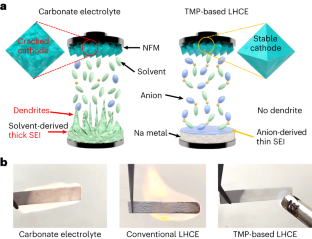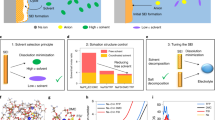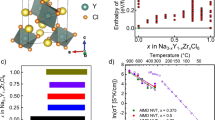Abstract
Sodium-metal batteries are an appealing, sustainable, low-cost alternative to lithium metal batteries due to the high abundance and theoretical specific capacity (1,165 mA h g−1) of sodium. However, the poor compatibility of the electrolyte with the cathode and anode leads to unstable electrode–electrolyte interphases. Here we introduce the concept of using a salt as a diluent, which enables the use of a single non-flammable solvent, such as trimethyl phosphate. By using sodium nitrate (NaNO3) salt as a model diluent, we report a 1.1 M NaFSI–NaNO3–trimethyl phosphate electrolyte that forms a stable interface with sodium-metal anode. In addition, the formation of robust cathode–electrolyte interphases on Na(Ni0.3Fe0.4Mn0.3)O2 cathode facilitates smooth phase transitions, thus leading to stable cycle life with a capacity retention of 80% over 500 cycles at C/5 rate in Na||Na(Ni0.3Fe0.4Mn0.3)O2 cells. The work demonstrates a promising approach towards the development of safe, low-cost, sustainable high-performance sodium-metal batteries.
This is a preview of subscription content, access via your institution
Access options
Access Nature and 54 other Nature Portfolio journals
Get Nature+, our best-value online-access subscription
$29.99 / 30 days
cancel any time
Subscribe to this journal
Receive 12 digital issues and online access to articles
$119.00 per year
only $9.92 per issue
Buy this article
- Purchase on Springer Link
- Instant access to full article PDF
Prices may be subject to local taxes which are calculated during checkout






Similar content being viewed by others
Data availability
All data are available in the article and its Supplementary Information files.
References
Yu, Z. et al. Molecular design for electrolyte solvents enabling energy-dense and long-cycling lithium metal batteries. Nat. Energy 5, 526–533 (2020).
Yan, P. et al. Tailoring grain boundary structures and chemistry of Ni-rich layered cathodes for enhanced cycle stability of lithium-ion batteries. Nat. Energy 3, 600–605 (2018).
Weber, R. et al. Long cycle life and dendrite-free lithium morphology in anode-free lithium pouch cells enabled by a dual-salt liquid electrolyte. Nat. Energy 4, 683–689 (2019).
Manthiram, A. A reflection on lithium-ion battery cathode chemistry. Nat. Commun. 11, 1550 (2020).
Su, L., Charalambous, H., Cui, Z. & Manthiram, A. High-efficiency, anode-free lithium metal batteries with a close-packed homogeneous lithium morphology. Energ. Environ. Sci. 15, 843–854 (2022).
Kim, M. S. et al. Langmuir–Blodgett artificial solid-electrolyte interphases for practical lithium metal batteries. Nat. Energy 3, 889–898 (2018).
You, Y. et al. Insights into the improved high-voltage performance of Li-incorporated layered oxide cathodes for sodium-ion batteries. Chem https://doi.org/10.1016/j.chempr.2018.05.018 (2018).
You, Y. et al. Subzero-temperature cathode for a sodium-ion battery. Adv. Mater. 28, 7243–7248 (2016).
Zhang, S., Yao, Y. & Yu, Y. Frontiers for room-temperature sodium–sulfur batteries. ACS Energy Lett. 6, 529–536 (2021).
Seh, Z. W., Sun, J., Sun, Y. & Cui, Y. A highly reversible room-temperature sodium-metal anode. ACS Cent. Sci. 1, 449–455 (2015).
Xin, S., Yin, Y., Guo, Y. & Wan, L. A high-energy room-temperature sodium–sulfur battery. Adv. Mater. 26, 1261–1265 (2014).
Sun, B. et al. Design strategies to enable the efficient use of sodium-metal anodes in high-energy batteries. Adv. Mater. 32, 1903891 (2019).
Yang, Z. et al. Fire‐retardant, stable‐cycling and high‐safety sodium ion battery. Angew. Chem. Int. Ed. 60, 27086–27094 (2021).
Gao, H., Xue, L., Xin, S., Park, K. & Goodenough, J. B. A plastic-crystal electrolyte interphase for all-solid-state sodium batteries. Angew. Chem. Int. Ed. 56, 5541–5545 (2017).
Wang, H., Wang, C., Matios, E. & Li, W. Facile stabilization of the sodium-metal anode with additives: unexpected key role of sodium polysulfide and adverse effect of sodium nitrate. Angew. Chem. Int. Ed. 57, 7734–7737 (2018).
Lamb, J. & Manthiram, A. Stable sodium-based batteries with advanced electrolytes and layered-oxide cathodes. ACS Appl. Mater. Interfaces 14, 28865–28872 (2022).
Fang, W. et al. Stable sodium-metal anode enhanced by advanced electrolytes with SbF3 additive. Rare Met. https://doi.org/10.1007/s12598-020-01576-1 (2020).
Jiang, Y. et al. Artificial heterogeneous interphase layer with boosted ion affinity and diffusion for Na/K‐metal batteries. Adv. Mater. 34, 2109439 (2022).
Zhu, M. et al. Dendrite-free sodium-metal anodes enabled by a sodium benzenedithiolate-rich protection layer. Angew. Chem. Int. Ed. 59, 6596–6600 (2020).
Wang, A. et al. Processable and moldable sodium-metal anodes. Angew. Chem. Int. Ed. 56, 11921–11926 (2017).
Cao, R. et al. Enabling room-temperature sodium-metal batteries. Nano Energy 30, 825–830 (2016).
Zheng, J. et al. Extremely stable sodium-metal batteries enabled by localized high-concentration electrolytes. ACS Energy Lett. 3, 315–321 (2018).
Wang, Y. et al. Enhanced sodium-metal/electrolyte interface by a localized high-concentration electrolyte for sodium-metal batteries: first-principles calculations and experimental studies. ACS Appl. Energ. Mater. 4, 7376–7384 (2021).
Jin, Y. et al. Highly reversible sodium-ion batteries enabled by stable electrolyte-electrode interphases. ACS Energy Lett. 5, 3212–3220 (2020).
Niu, C. et al. High-energy lithium metal pouch cells with limited anode swelling and long stable cycles. Nat. Energy https://doi.org/10.1038/s41560-019-0390-6 (2019).
Shi, P. et al. A highly concentrated phosphate-based electrolyte for high-safety rechargeable lithium batteries. Chem. Commun. 54, 4453–4456 (2018).
Zeng, Z. et al. A safer sodium-ion battery based on non-flammable organic phosphate electrolyte. Adv. Sci. 3, 1600066 (2016).
Jiang, X. et al. A non-flammable Na+-based dual-carbon battery with low cost, high voltage, and long cycle life. Adv. Energy Mater. 8, 1802176 (2018).
He, J., Bhargav, A., Shin, W. & Manthiram, A. Stable dendrite-free sodium–sulfur batteries enabled by a localized high-concentration electrolyte. J. Am. Chem. Soc. 143, 20241–20248 (2021).
Mu, L. et al. Deciphering the cathode–electrolyte interfacial chemistry in sodium layered cathode materials. Adv. Energy Mater. 8, 1801975 (2018).
Su, L. et al. Multiscale operando X-ray investigations provide insights into electro-chemo-mechanical behavior of lithium intercalation cathodes. Appl. Energy 299, 117315 (2021).
Su, L. et al. Tailoring electrode–electrolyte interfaces in lithium-ion batteries using molecularly engineered functional polymers. ACS Appl. Mater. Interfaces 13, 9919–9931 (2021).
Lamb, J., Stokes, L. & Manthiram, A. Delineating the capacity fading mechanisms of Na(Ni0.3Fe0.4Mn0.3)O2 at higher operating voltages in sodium-ion cells. Chem. Mat. 32, 7389–7396 (2020).
Lamb, J. & Manthiram, A. Surface-modified Na(Ni0.3Fe0.4Mn0.3)O2 cathodes with enhanced cycle life and air stability for sodium-ion batteries. ACS Appl. Energ. Mater. 4, 11735–11742 (2021).
Lamb, J., Jarvis, K. & Manthiram, A. Molten‐salt synthesis of O3‐type layered oxide single crystal cathodes with controlled morphology towards long‐life sodium‐ion batteries. Small 18, e2106927 (2022).
Hafner, J. & Kresse, G. Ab initio molecular-dynamics simulation of the liquid-metal–amorphous-semiconductor transition in germanium. Phys. Rev. B 49, 14251–14269 (1994).
Hafner, J. & Kresse, G. Ab initio molecular dynamics for liquid metals. Phys. Rev. B 47, 558–561 (1993).
Burke, K., Ernzerhof, M. & Perdew, J. P. Generalized gradient approximation made simple. Phys. Rev. Lett. 77, 3865–3868 (1996).
Blöchl, P. E. Projector augmented-wave method. Phys. Rev. B 50, 17953–17979 (1994).
Martínez, L., Andrade, R., Birgin, E. G. & Martínez, J. M. PACKMOL: a package for building initial configurations for molecular dynamics simulations. J. Comput. Chem. 30, 2157–2164 (2009).
Pack, J. D. & Monkhorst, H. J. Special points for Brillouin-zone integrations. Phys. Rev. B 13, 5188–5192 (1976).
Acknowledgements
This work was supported by the US Department of Energy, Office of Basic Energy Sciences, Division of Materials Science and Engineering under award number DE-SC0005397.
Author information
Authors and Affiliations
Contributions
J.H., A.B. and A.M. conceived the idea. J.H. performed electrolyte formulations, collected electrochemical data and wrote the paper. A.B. performed the FTIR, NMR and pouch cell experiments. J.O. and L.S. performed the Synchrotron-based operando ED–XRD and corresponding analysis. J.L. provided the NFM cathode. W.S. performed theoretical calculations. A.M. supervised the project and edited the paper. All authors discussed the results and reviewed the paper.
Corresponding author
Ethics declarations
Competing interests
J.H., A.B. and A.M. declare that this work has been filed as International Patent Application number PCT/US2023/029298. All other authors declare no competing interests.
Peer review
Peer review information
Nature Energy thanks Michel Armand and the other, anonymous, reviewer(s) for their contribution to the peer review of this work.
Additional information
Publisher’s note Springer Nature remains neutral with regard to jurisdictional claims in published maps and institutional affiliations.
Supplementary information
Supplementary Information
Supplementary Figs. 1–30, Tables 1–5 and discussion.
Supplementary Video 1
The carbonate electrolyte easily catches fire.
Supplementary Video 2
The conventional LHCE easily catches fire.
Supplementary Video 3
TMP acts as an effective fire extinguisher, scavenging the active hydrogen radicals and preventing the combustion chain reaction, so the NaFSI–NaNO3–TMP electrolyte shows impressive non-flammability.
Rights and permissions
Springer Nature or its licensor (e.g. a society or other partner) holds exclusive rights to this article under a publishing agreement with the author(s) or other rightsholder(s); author self-archiving of the accepted manuscript version of this article is solely governed by the terms of such publishing agreement and applicable law.
About this article
Cite this article
He, J., Bhargav, A., Su, L. et al. Tuning the solvation structure with salts for stable sodium-metal batteries. Nat Energy 9, 446–456 (2024). https://doi.org/10.1038/s41560-024-01469-y
Received:
Accepted:
Published:
Issue Date:
DOI: https://doi.org/10.1038/s41560-024-01469-y
This article is cited by
-
Diluting with salts
Nature Energy (2024)



